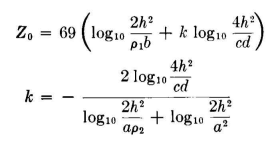| Radio Antenna Engineering is a free introductory textbook on radio antennas and their applications. See the editorial for more information.... |

|

Home  Radio-frequency Transmission Lines Radio-frequency Transmission Lines  Useful Transmission-line Configurations Useful Transmission-line Configurations  More than Four Wires More than Four Wires  Six-wire Unbalanced Line Six-wire Unbalanced Line |
||||||||||||||||||||






|
||||||||||||||||||||
|
Six-wire Unbalanced LineAuthor: Edmund A. Laport
Figures 4.68 to 4.73 show various constructional details that have been used at different broadcast stations. As constructed using wires of radius 0.064 inch, this line is capable of transmitting a peak power of the order of 600 kilowatts, and with larger conductors this rating , can be increased. Its characteristic impedance, of the order of 230 ohms in its usual form, is a very convenient value for broadcasting applications because the coupling networks usually require values of inductance and capacitance readily realizable with available components. When h >> a,
When ρ1 = ρ2,
A set of characteristic values is:
|
||||||||||||||||||||
Home  Radio-frequency Transmission Lines Radio-frequency Transmission Lines  Useful Transmission-line Configurations Useful Transmission-line Configurations  More than Four Wires More than Four Wires  Six-wire Unbalanced Line Six-wire Unbalanced Line |
||||||||||||||||||||
Last Update: 2011-03-19




